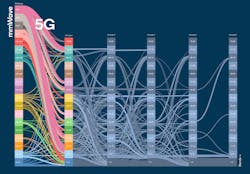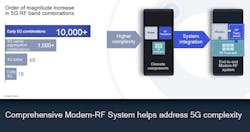6 Reasons to Move to a Complete Modem-to-Antenna Solution in the Era of 5G
This article appeared in Electronic Design and has been published here with permission.
What you’ll learn:
- How the smartphone industry is transforming with 5G.
- How 5G complicates RF design.
- How to tame 5G RF complexity.
With multi-gigabit 5G speeds, reliability, security, and ultra-low latency, the 5G rollout will impact consumers, businesses, governments, and institutions all over the world, transforming every industry and life as we know it. In fact, according to recent data from IHS Markit, the 5G value chain will support 22.8 million jobs and deliver $3.8 trillion in economic output by 2035.
Surging demand for 5G smartphones—Qualcomm expects over 750 million 5G smartphones to be shipped by 2022—will accelerate the race toward one billion 5G connections globally by 2023, outpacing 4G adoption by two years. Behind these dizzying stats lies a herculean challenge: Taming complexity as new smartphones are required to support legacy 2G/3G/4G and a host of new 5G frequency bands, such as sub-6-GHz and mmWave. Such capabilities will ultimately help deliver broader coverage, multi-gigabit speeds, and high-speed internet access to mobile devices and many new segments as automotive, infrastructure, connectivity, and industrial IoT.
The adoption of 5G will enable many industries to fast track their digital transformation, leading to better efficiencies and competitiveness. However, 5G is much more complex than previous generations. Smartphone OEMs and new wireless providers offering 5G solutions can no longer rely on component-centric approaches to meet customer expectations. To reap the full benefits of 5G, OEMs must look to a complete modem-to-antenna system solution.
Complexity Tsunami
The promise of delivering 5G globally can only be realized by taming RF front-end (RFFE) complexity in 5G devices. In the early stages of 4G, there were just 16 RF band carrier aggregation combinations. By contrast, we expect over 10,000 band combinations with 5G in the next few years alone, a complexity tsunami that has a direct impact on the design, assembly, and certification of 5G smartphones.
From modem to antenna, new 5G mobile devices must dance between myriad frequency bands and RF technologies, including MIMO (4x4 DL, 2x2 UL); Dynamic Spectrum Sharing (DSS); E-UTRAN New Radio – Dual Connectivity (EN-DC); beamsteering; carrier aggregation; and mmWave.
Moreover, the RFFE is a tangled web of existing and new low-, mid-, and high-spectrum bands, unlicensed bands (CBRS, etc.), navigation technologies, and short-range connectivity solutions including Wi-Fi 6 and Bluetooth. A broad range of RF technologies and frequency bands will demand a host of new filters/power amplifiers/low-noise amplifiers on the smartphone RFFE architecture, allowing 5G smartphones to tune all of these frequencies simultaneously, precisely, and with less disturbance while requiring minimum battery power consumption.
Burrowing down deeper, the quantum leap in complexity can be seen at the filter and antenna level, too. While today we speak in the range of 100 filters on a single premium 5G smartphone, 4G phones initially came with less than 30 filters.
Another hurdle is the diverse array of antennas required for the precise tuning of the many new bands/technologies entering the marketplace. Today, we typically work with eight to 10 antennas (on a premium 5G phone we can expect 10 antennas), whereas the initial 4G/5G phones supported six antennas.
Finally, all of these components must be elegantly squeezed into ever-shrinking 5G form factors and extensively tested globally to deliver the best modem-to-antenna RF quality. This will help ensure your phone seamlessly works wherever you are around the world.
Why Move to a Complete Modem-to-Antenna Solution?
Though the complexity labyrinth can be challenging to navigate, here are six reasons why OEMs and new wireless vendors should move to a complete modem-to-antenna solution:
- A complete solution maximizes a device’s system performance by benefiting from hardware-software co-design advantages. This results in a better user experience—data speeds, coverage, responsiveness, fewer dropped calls, sleeker devices—while lowering device power consumption.
- With a proven modem-to-antenna solution, OEMs and wireless vendors can spend less time on hardware integration and testing, focusing more on the industrial design and user interface, creating better products.
- Faster integration of new 5G technologies and use cases.
- Pre-baked, comprehensive solutions help reduce the R&D burden on OEMs while lowering the cost for 5G development, design, assembly, and production.
- Reduces time for device testing and certification for operators around the world.
- Simplifies the modem-RF procurement process.
Engineers and designers throughout the world are acting quickly to adopt complete modem-to-antenna solutions, including LG, Motorola, OnePlus, OPPO, Samsung, Sony, Vivo, Xiaomi, and many more. As 5G’s footprint continues to grow, OEMs and wireless providers must integrate the best RFFE solution to realize the promise of the 5G future, helping their customers reap the rewards of high-speed connectivity, reliability, and ultra-low latency.


